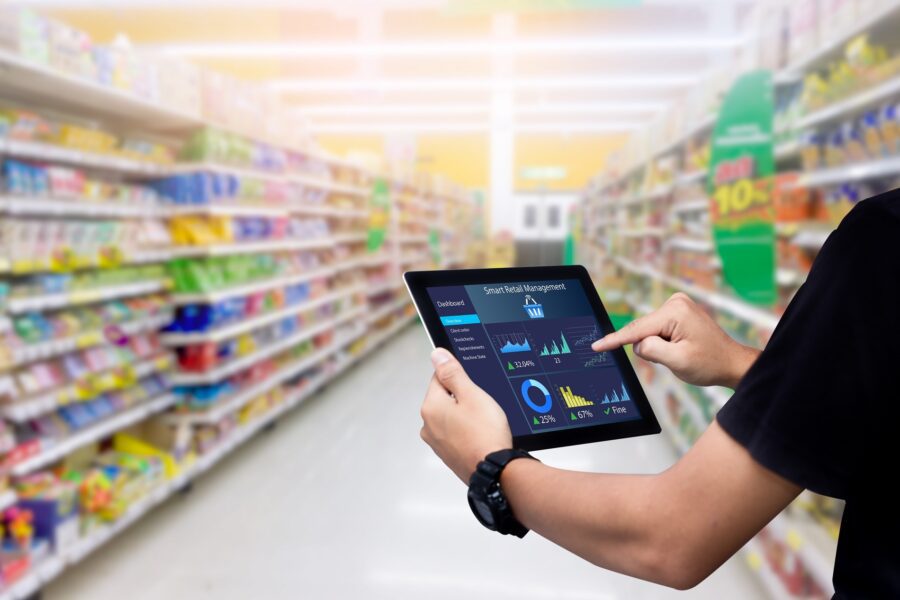Retail
Retail Trends Transforming the Industry
Written by: Parcel Pending
9 Min Read
Published: July 19, 2019
Updated: April 4, 2023
It’s a perilous time for retailers to stick to the status quo. Every day, emerging technologies are changing the way companies interact with their existing customers, attract new business, and sell their products. For companies that fail to embrace these change—think Toys r Us, Blockbuster, RadioShack—the consequences range from irrelevance to outright bankruptcy.
However, while the consequences of failing to embrace new retail trends might be drastic, so are the benefits of embracing and utilizing new technologies and tactics:
- Companies can reach customers that would have otherwise been inaccessible
- Companies can use emerging tech to create memorable, engaging customer experiences
- Companies can streamline their retail process, improving convenience for the customer
So, what exactly are these transformative trends, and how are companies adopting them to get an edge on their less-than-savvy competitors?
Friction-Free Commerce
Modern consumers want quick, efficient retail experiences, and successful companies know how to deliver them. Enter the theory of “friction-free commerce.”
- Friction-free commerce attempts to eliminate roadblocks, or “friction,” which prevents retail customers from quickly completing easy purchases
A recent study found that 68% of the time, online shopping carts are abandoned. It was theorized that this surprisingly high number had to do with the number of unexpected costs, the number of forms customers were expected to fill out, and the number of actions they’re asked to perform before finalizing their order.
Innovative companies have figured out how to eliminate these roadblocks, and in the process have been able to improve the customer’s shopping experience, both online and in-person. Here are a few popular examples:
- Apple: If you enter an Apple store, you find that almost every employee has a smartphone or tablet in hand. Employees are able to finalize sales from these devices, which has eliminated lengthy checkout lines.
- Amazon: Amazon’s 1-click ordering and one to two-hour delivery options epitomize friction-free commerce. With just a single click, the delivery process is initiated.
By making the process of retail sales hassle-free, companies are finding that it’s easier to make sales and retain customers.
Click and Collect
Click and collect is an emerging trend that makes it easier for customers to order items online (click) and then pick them up at a secured location (collect). Parcel Pending electronic locker systems are compatible with click and collect services, and have been used to:
- Create a frictionless pick-up package retrieval experience for customers who have ordered online or in-store with order pickup lockers
- Alert customers that orders are ready the moment they have been delivered
- Provide safe and secure storage when customers can’t immediately pick up packages that have been delivered
- Allow retail staff to focus on the customer’s in-store experience rather than package management
The momentum behind the click-and-collect trend seems unstoppable, and the list of benefits for retailers seems to go on and on.
In a recent Reuters article, the chief executive of the International Council of Shopping Centers was quoted as saying, “More than a third of customers who come to collect their orders end up buying something else.” He went on, saying that during the holiday season that number jumps to 86 percent.
That means that businesses that incorporate click and collect are not only streamlining the experience for the customer, they are actually selling more of their product, to the tune of 33%. It’s hard to imagine a business owner who would pass on the opportunity to increase revenue by at least one third by making a one-time investment.
Omnichannel Retail Strategy
Most retailers have heard the phrase “omnichannel,” but there are so many conflicting definitions floating around that it can be hard to be sure what it means. To add to the confusion, the phrase “multichannel” often gets used interchangeably with “omnichannel”, when in fact the two terms mean entirely separate things.
Let’s clear things up:
- An omnichannel retail strategy is a fully integrated shopping experience offered to a consumer by a retailer. It is a holistic strategy that involves merging social media, mobile-browsing, brick and mortar, etc., so that customers have a streamlined way to access a company’s product.
- Multichannel retail strategy is when a company attempts to develop several different avenues for a consumer to access their product, but those avenues are not necessarily integrated with one another. For example, they may have an online store, a social media account, and a brick and mortar store location, but one does not necessarily interact with the others.
Multichannel retail marketing strategies are now the norm, but a number of companies have learned how to take advantage of omnichannel retail strategies. Of those advantages, one of the most beneficial to a company is the ability to deliver a consistent brand message.
Because an omnichannel retail strategy merges otherwise disparate retail channels, marketers are able to clearly and uniformly define their brand. This makes it easier to cultivate customer loyalty, and to build an identity that might otherwise be fragmented or inconsistent.
Omnichannel retail has also been shown to lead to immediate revenue increases. Because the experience of omnichannel retail is so immersive, consumers tend to spend 4% more at brick-and-mortar locations, and up to 10% more when purchasing products online.
Here’s one more statistic that should convince traditional retailers they should adopt an omnichannel retail strategy: 67% of customers who begin a retail purchase online initiate the process on one device and finish on another or in the physical store. This remarkable number highlights the importance of a consistent sales experience; a mark which multichannel strategies often fail to hit.
Experiential Retail
No matter how good your product might be, every company must figure out how to distinguish itself from competitors. There are 28 million small businesses in the United States, which means that virtually every business will encounter competition. Given this statistic, what becomes necessary is the ability to engage customers in a way that is both memorable and enjoyable.
Enter experiential retail, a trend that many top companies have gleefully embraced.
Just as the name suggests, experiential retail means that customers are offered a unique experience, above and beyond what they might expect during a standard retail experience. There are no guidelines for experiential retail, only that companies develop an elevated sales experience. This can take many forms, including:
- Live music in-store
- Virtual reality experiences which allow users to engage in unique ways with products
- Creative experiences for in-store shopping tailored to fit the brand’s identity
Through experiential retail, businesses have the opportunity to:
- Create an unforgettable customer experience
- Build a strong brand identity
With 28 million businesses competing for the attention of consumers, companies should be brainstorming ways to use experiential retail to set themselves apart. By adding minor alterations to the sales experience—through interactive, in-store catalogs, for example—it’s possible to create moments that will cause customers to return to your brand when faced with alternative options.
Commerce through Social Media
Social media is no longer a new phenomenon, but that doesn’t mean that businesses aren’t coming up with new ways to use these platforms to engage with customers. Profits are driven by a company’s ability to reach customers, and with billions of users on social media platforms, businesses that overlook this channel will inevitably cripple their outreach.
Messaging
According to Statistica, 1.3 billion Facebook users use Facebook Messenger in a given month. That should be an eye-popping number for businesses who are having trouble meeting customers where they are.
There are several advantages to using social media messaging to improve outreach, but perhaps the biggest advantage is that it’s instantaneous.
- “Read receipts” allow both retailers and customers to see when messages have been received
- The inherent delays of email are eliminated
- Customers don’t have to dig around for phone numbers or addresses
By using either bots or staffers, many companies have started to use these messaging services to reach customers at all times of the day. It’s no longer the case that businesses have to wait for customers to approach them.
Create a Community for Consumers
Clever brands know how to cultivate their social media platforms so that they become communities where their consumers can interact. The logic here is simple: the more online time consumers spend in close proximity to a company’s product, the more likely they are to buy something.
Brands that have the most success creating communities do so by engaging consumers with their social media posts, posing questions online that encourages feedback, and by offering perks like product giveaways.
“Shop Now” Buttons
Social media platforms like Instagram have launched “Shop Now” buttons, which allows companies to monetize their social media platforms. In terms of e-commerce, this is a huge development which allows brands to simultaneously build brand identity while giving consumers the option to directly purchase products.
Mobile is Ubiquitous
While it’s possible for some of us, it’s difficult to imagine life before cellphones were ubiquitous. According to research by the Pew Research Center, 95% of Americans own a cellphone, and smartphone ownership increased from 35% in 2011 to 77% in 2018. Those numbers are staggering, and it seems like soon everyone will have a miniature computer in their pocket.
So, what do these numbers mean for online retailers? Consider this:
- In 2018, sales conducted through mobile devices accounted for 117 billion dollars, a number that is expected to grow to 209 billion by 2022
This trend points to several facts that business owners and online retailers need to face. The first is that virtually every company, no matter what product they may be selling, needs to cultivate an online presence—or at the very least have a website. Consumers search for products using services like Yelp, and by scrolling through pages of Google results, the retail companies that don’t appear in these searches will be seriously disadvantaged.
Even when shoppers enter a brick and mortar retail location, a recent study conducted by InReality found that 75% of these consumers use their mobile devices while at the physical location. They check prices against competitors, search for the best available product, and consult with their friends about possible purchases.
Businesses Investing in Retaining Top Tier Talent
The economy is on the upswing, and as a result, workers have increased employment opportunities. If they feel that they are being underpaid or undervalued, they can simply apply for another job and begin somewhere else.
This has put immense pressure on employers—especially in the wake of the recent expose regarding the way Facebook has treated its content moderators—to make it worth employees’ time to stay with a company for the long haul. Employees who excel in their positions are invaluable to businesses, and could be potentially damaging if they moved to a competitor.
This trend has manifested in several different ways across industries. One of the most common ways of retaining valuable employees has been by bumping up the minimum wage offered to workers at companies like Wal-Mart, Gap, Whole Foods and Abercrombie. In tech, entertainment, and the business sphere, employees are enticed with wage increases, equity, and office perks.
Final Thoughts
The through-line between all of these trends is the meteoric rise of technology. Whether that means the ubiquity of mobile phones, the ability to incorporate an omnichannel retail marketing strategy, or the importance of social media, these trends point to the simple fact that companies need to be willing to embrace tech, or they may end up being swallowed by competitors.
However, the silver lining is that by embracing these trends, companies can edge out their competition in ways that makes their brand memorable to consumers. By using experiential retail, by creating communities through social media channels, and by incorporating click and collect options through the use of Parcel Pending lockers, businesses not only make purchasing products more convenient for customers but also allow their brand to stand out from the crowd.
Sources:
Number of social media users worldwide 2010-2021. (n.d.). Retrieved May 10, 2019, from https://www.statista.com/statistics/278414/number-of-worldwide-social-network-users/
O’Shea, D. (2018, August 24). Mobile sales to hit $117B in 2018. Retrieved May 10, 2019 from https://www.retaildive.com/news/mobile-sales-to-hit-117b-in-2018/530852/
Pleska, J. (2017, May 23). 6 Benefits of Choosing an Omnichannel Strategy. Retrieved May 10, 2019 from https://blog.monkeydata.com/6-benefits-of-choosing-an-omnichannel-strategy-e8a019506857



